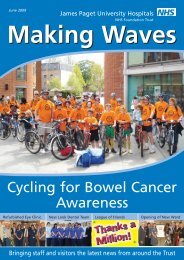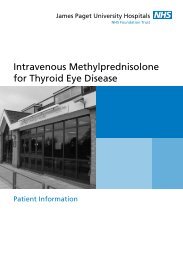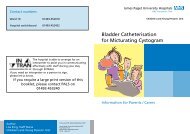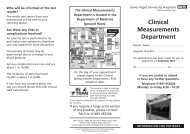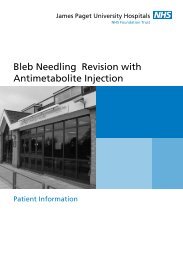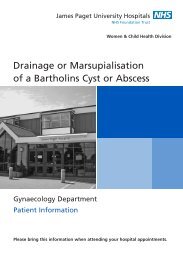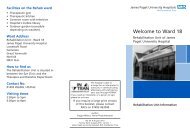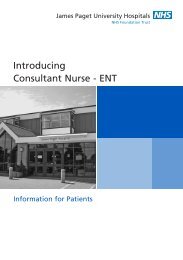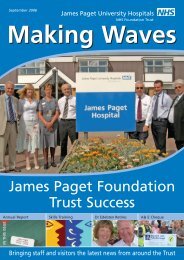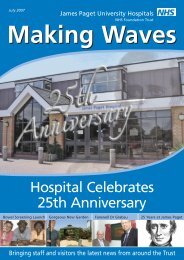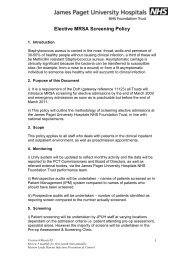Quality Account 2010/11 - James Paget University Hospitals
Quality Account 2010/11 - James Paget University Hospitals
Quality Account 2010/11 - James Paget University Hospitals
You also want an ePaper? Increase the reach of your titles
YUMPU automatically turns print PDFs into web optimized ePapers that Google loves.
Priority 1b: Patient safety – Reduction in mortality rates<br />
AIM: To integrate HSMR measures into clinical and managerial<br />
processes<br />
The Hospital Standardised Mortality Ratio (HSMR) is an indicator of healthcare quality that<br />
measures whether the death rate at a hospital is higher or lower than you would expect. Like<br />
all statistics, HSMRs are not perfect. If a hospital has a high HSMR, it cannot be said for<br />
certain that this reflects failings in the care provided by the hospital. However, it can be a<br />
warning sign that things are going wrong.<br />
The HSMR compares the expected rate of death in a hospital with the actual rate of death for<br />
a number of diagnoses, for example, heart attacks, strokes or broken hips. For each group<br />
of patients it is possible to work out how often, on average, across the whole country, they<br />
survive their stay in hospital. This is achieved by taking into account their age, the severity of<br />
their illness and other factors, such as whether they live in a more or less deprived area. This<br />
provides a figure for how many patients we would expect to die at each hospital. This is then<br />
compared with the number of patients that actually die. If the two numbers are the same, the<br />
hospital gets a score of 100. If the number of deaths is ten per cent less than expected they<br />
get a score of 90. If it is ten per cent higher than expected, they score <strong>11</strong>0.<br />
Care is needed in interpreting these results. Just through chance, some hospitals will have a<br />
higher mortality rate and some a lower rate. It is inevitable that half the hospitals will have a<br />
worse than average result and that some will be quite a lot worse than the average. It is<br />
important to focus on "outliers". These are hospitals where the results lie outside the normal<br />
range, or particular groups of conditions where results lie outside the normal range, for a<br />
particular hospital.<br />
An HSMR 14 point action plan has been approved by the Trust’s Board of Directors and<br />
Management Team, to integrate the use of HSMR data with other tools. Specialties with a<br />
higher than average mortality rate can understand why this has occurred and take any<br />
necessary steps to improve. The action plan will be owned by the Trust’s Management Team<br />
and progress against the actions will be monitored through the existing performance<br />
management processes. A regular update on progress will be provided to both the Board of<br />
Directors and Management Team throughout the year.<br />
Executive Sponsor: Medical Director<br />
Responsible officer: Deputy Director of Performance<br />
Objectives: The Trust aims to reduce its overall and specialty specific HSMR to less than<br />
100 throughout 20<strong>11</strong>/12.<br />
<strong>James</strong> <strong>Paget</strong> <strong>University</strong> <strong>Hospitals</strong> NHS Foundation Trust<br />
<strong>Quality</strong> <strong>Account</strong> <strong>2010</strong>/<strong>11</strong> Page 10 of 62




